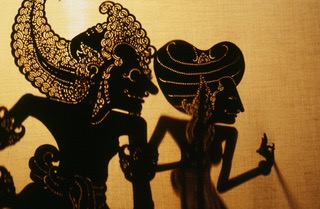Unexpected monsters seek charge of the world...
Wayang Bali, the Balinese shadow play, is one of the most exciting undiscovered events of world theater. Until recently, language barriers have kept its drama and humor hidden from the world at large. Plots for Wayang Bali are drawn from the Mahabharata myth cycle, in which five brothers are pitted against one hundred jealous cousins in a struggle for power involving gods, demons, magical weapons, and the inevitable beautiful princess.
Join us on Saturday, June 25, 2016 at 8:00pm for an Evening of Balinese Shadow Play performed by Larry Reed at St. Cyprian's Church (2097 Turk Street, SF)
Tickets: $20 in advance, $25 at the door
$18 students, children & seniors
www.noevalleymusicseries.com
Box Office: 415-454-5238
Ticket Sales: http://www.brownpapertickets.com/event/2553039
Facebook event: https://www.facebook.com/events/1316892795004906/
More about Balinese Shadow Play - Wayang Bali
According to Balinese philosophy, a wayang performance is a symbol of the cosmos. The dalang (Shadow Master) represents God; the screen represents the world, including the atmosphere; the damar (oil lamp – in tonight’s case, electric lamp) is the sun and the banana log underneath the screen is the earth on which the creatures work; the wayang (puppet characters) are the creatures. The accompanying gender music represents irama djaman, which means in phase with the periods of history.
A Balinese shadow play is used to complete a religious ceremony and also for entertainment. It is accompanied by two or four instruments called gender wayang, which have ten bronze keys suspended over bamboo resonators. Each instrument plays an individual but complementary part so that the full melody is realized only if the two parts are played together. If four instruments are used, the second pair is tuned one octave higher than the first and the parts are simply doubled.
The dalang (shadow master/puppeteer) must know many stories from the Mahabharata, Ramayana, and traditional Balinese literature. In addition, he must know music, dance, singing, and drama, and sometimes he also knows painting and carving. During a performance, he holds a small gavel called chepala between his right toes with which he pounds on the wooden wayang box to accompany the actions of the puppets and to signal to the musicians. He must be able to create the voices and dialects of many characters. The characters speak Kawi, old Javanese – an ancient language close to Sanskrit, except for the servant characters who translate the proceedings into Balinese for the benefit of the audience, most of whom do not understand Kawi. The puppets are divided according to their character. The “good” characters are place on the right side of the dalang; the “evil” ones on his left. Of course this division is not black and white as there are some good in every bad character and any good character might have certain weakness. In the course of a performance, close battles may occur between the forces of good and evil, the right side will always triumph.


